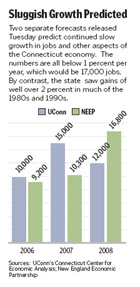 |
 |
|||
|
||||
| Web Sites, Documents and Articles >> Hartford Courant News Articles > | ||
|
State Job Growth Lags UConn Economists Predict Steady Gains November 15, 2006 Connecticut's economy is making progress. The unemployment rate is low, fewer people are unemployed and real income is on the rise. But the sticking point for the state's economy is the tortoise-like rate at which new jobs are being created.
Connecticut has had "agonizingly slow, but rising job growth this year," said Edward J. Deak, a professor of economics at Fairfield University who prepared the projections for Connecticut. "We're positive we've generated jobs, but it is very slow," Deak told a group of about 100 business executives, economists and development officials at the organization's fall conference Tuesday in Westborough, Mass. A bit of good news is that Connecticut is likely to feel the annual bonuses for 2006 that are coming out of Wall Street. The money is going to filter into the state, particularly Fairfield and Hartford counties, Deak said. "That certainly is going to support additional consumer spending, and also support the housing market. We're talking big bucks here." Separately, economists at the University of Connecticut released a forecast Tuesday that also calls for steady job growth. Such growth could attract people into the labor force that are already here, Deak said. These are people "who are not working, who are not looking for jobs because they don't have any expectation of being hired. If you're a skilled employee in Connecticut, an accountant, an engineer ... you can expect to find a job. But for someone with a high school education, there is not a lot of opportunity." The report by UConn's Center for Economic Analysis said that because of very strong gains in productivity - the amount of goods and services produced with each hour of work - the additional jobs created by the state's economy would be a relatively low 10,000 this year, but would pick up in 2007. The construction and manufacturing sectors are losing jobs, the UConn report said. It added, "Even as Connecticut incomes continue their impressive growth, there are far too few jobs in prospect for the state's high school graduates, who number nearly 35,000 annually." The housing market, which has softened, could fall further or even rise back up sooner than expected, the UConn report said, depending on energy prices. "Despite the sharp decline in housing permits and the national angst over the housing sector, the CCEA outlook for the Connecticut housing sectors argues for a soft landing in the state, and even improving availability of starter homes." Nationally, an aging workforce and a decrease in the number of immigrants is slowing the economy's growth rate. Those factors, which are pulling down the national growth rate, are even more pronounced in New England, said Ross Gittell, the New England Economic Partnership's forecast manager. New England is expected to grow below the national average, said Gittell, a University of New Hampshire economist. Gittell also attributed part of New England's lag to relatively slow growth in some of the region's most important economic sectors, including finance, and professional and business services. "As a region we're slower in terms of job creation and entrepreneurial growth," Deak added. In July 2000, the state's employment peaked at 1.7 million; it bottomed out at 1.64 million in September 2003. Through September 2006, the state has recovered about 57 percent of those jobs - 34,200 of the 60,000 jobs lost during and after the 2001 recession. Connecticut has had one of the slowest post-recession job recoveries in the nation. Although the U.S. is expected to have an average annual growth rate of 3.2 percent in total output of goods and services from 2005 to 2010, Connecticut's total output is forecast to have an average annual growth rate of 1.9 percent. Output in New England as a whole is expected to grow 2.3 percent annually during that same period.
|
||
| Last update:
September 25, 2012 |
|
||
|
 The state is expected to gain 9,200 jobs this year, and another 10,300 in 2007. In 2008, the nation's growth rate is expected to increase; as a result, Connecticut is expected to share in the uptick and register a gain of 16,800 jobs, according to a report released Tuesday by the New England Economic Partnership, a nonprofit organization that tracks economic trends in the six-state region.
The state is expected to gain 9,200 jobs this year, and another 10,300 in 2007. In 2008, the nation's growth rate is expected to increase; as a result, Connecticut is expected to share in the uptick and register a gain of 16,800 jobs, according to a report released Tuesday by the New England Economic Partnership, a nonprofit organization that tracks economic trends in the six-state region.